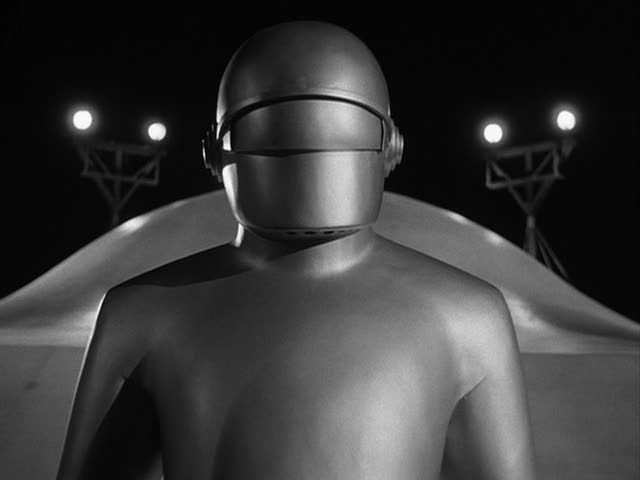
Filmed and released at the height of the Cold War, The Day the Earth Stood Still presented a bold call to look beyond national borders and quest for peace and unity rather than war. In particular, the film was an anti-nuclear parable, a grave warning that the consequences of nuclear warfare could be global or even cosmic, a far cry from even the greatest devastation resulting from conventional war. This message is delivered to the people of Earth by the very human-like alien Klaatu (Michael Rennie), who arrives in a spaceship accompanied by a tremendous, indestructible robot named Gort (played by real-life giant Lock Martin beneath a clumsy costume). The film's anti-war and anti-nuclear agenda was controversial in its day, just as its special effects were state of the art. Seen today, the message is utopian and obvious, while the effects look rudimentary, but the film stands up surprisingly well as a classic of its genre.
Partly, the film's enduring status as a sci-fi masterpiece, rather than a historical curiosity, can be attributed to the great use that is made of relatively modest effects. Director Robert Wise, coming to the film from a background in noir and horror, knows how to get the most from a minimalist aesthetic, and he slathers these sets in artfully applied shadows that give a realistic feel to the cardboard-like backdrops. Klaatu's ship, draped in shadows, has an unearthly ambiance as the alien walks around its circular inner chamber, turning on lights one at a time by waving his hand over rows of strange buttons. The lighting often keeps the alien himself shrouded from view, keeping him mysterious and aloof. Though he looks human and, for most of the film, attempts to blend in with humans, he is often kept at a remove, his thoughts and goals hidden from understanding.
Even Gort, who in the broad light of day risks looking kind of silly rather than threatening, is mostly filmed in ways that enhance his intimidating aura rather than exposing the awkward artifice of his costuming. The robot's cold, silent acts of destruction, mostly presented in inscrutable closeups on his blank face, are terrifying in their slow, deliberate inevitability. Wise manages to make this robot seem all-powerful and unstoppable with only a few unconvincing laser bursts and amorphous glowing effects. The film also achieves a great deal with its score, a minimal drone mostly played with a pair of theremins, and composed by the great Bernard Hermann. This score functions much like the sets, creating tension and suspense from a surprisingly ascetic foundation. From the very opening strains, over the credits sequence's static painted images of outer space, the music's whining pulsations create an uneasy mood, a sense of impending doom. The score, the sets, the lighting, the effects: all are unified in creating believable sci-fi from the most minimal starting point. The individual elements might be cheesy and makeshift, but the total effect is brilliant.

More importantly, the film succeeds because its emphasis is not on the whiz-bang bravura of its technical effects, but on the dramas triggered by the alien's arrival. The bulk of the film takes place on a very human scale, with Gort and the spaceship offscreen as Klaatu attempts to blend in with the people of Earth so that he can learn about them and understand their capacity for violence. When he arrives on the planet, bringing his message of peace, he is shot in the arm immediately by a skittish soldier who mistakes the gift he offers for a weapon. He soon escapes the military's custody and takes a room at a small boarding house, where he befriends the young widow Helen Benson (Patricia Neal) and her son Bobby (Billy Gray). Klaatu seeks to understand this race of people who react so instinctively with violence and fear, and if the film's overall message of peace is overly pat — giving up violence is hard to argue with and harder still to achieve — its insight into the global politics of fear is more acute. The film portrays a planet wracked with fear, suspicious and all too ready to believe the worst about others. It takes an alien outsider to question why this planet is so consumed by "us versus them" politics rather than taking a global view to preserve the integrity and survival of the planet as a whole.
Klaatu's interactions with Helen and Bobby provide him with a positive counterpoint to his experiences elsewhere on Earth, though Helen's boyfriend Tom (Hugh Marlowe) is just another suspicious jerk who's certainly not thinking globally: he's only out for himself. The film implicitly draws the connection between Tom's personal selfishness and the larger selfishness of nationalism. Whether it's one person putting personal gain above all else, or entire countries and governments valuing their own aims over the possibility of international cooperation, Klaatu simply doesn't understand this kind of short-sightedness. His tour of Washington with Bobby — taking in both the rows of graves at Arlington and the words of Abraham Lincoln at the Lincoln Memorial — encompasses both horror and hope for the potential of this planet's societies. For its subtle atmosphere and its overriding humanistic touch, The Day the Earth Stood Still remains one of the great achievements of the science fiction genre.

2 comments:
A compelling little movie - which has apparently been remade with Keanu Reeves dodging giant explosions in quick smash cuts. Hooray for Hollywood!
Yeah, I can't say I'm too excited for a remake, although Keanu is an oddly good choice for the alien: can you imagine anyone who can better handle the stoic, distant, strangely removed expression of Klaatu? That's pretty much the only expression Keanu can do.
Post a Comment